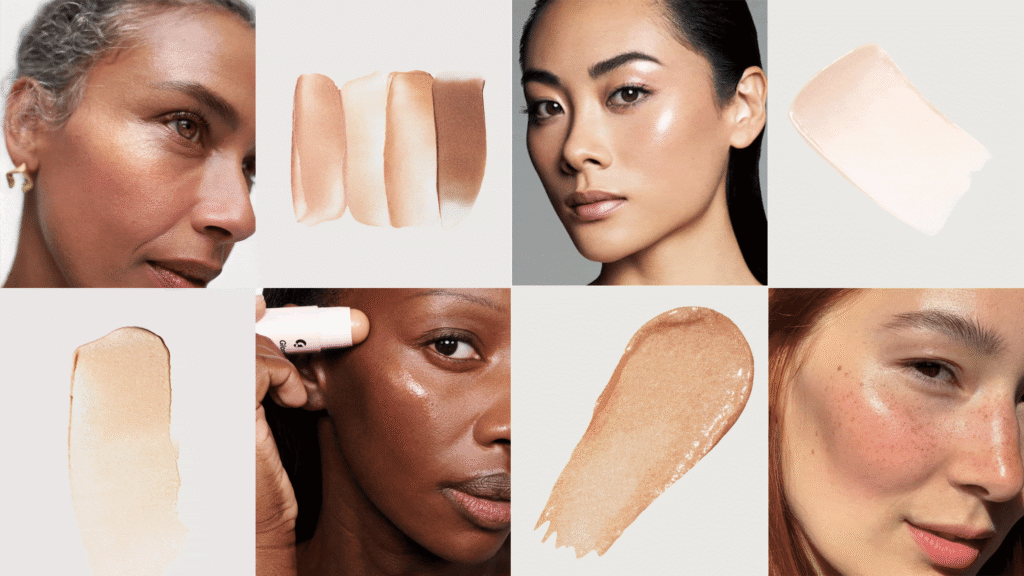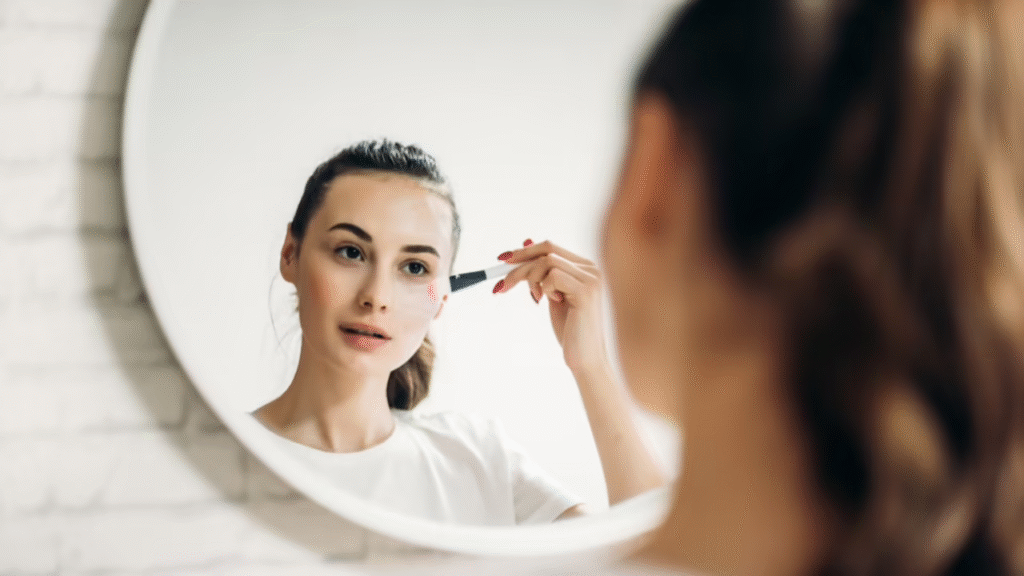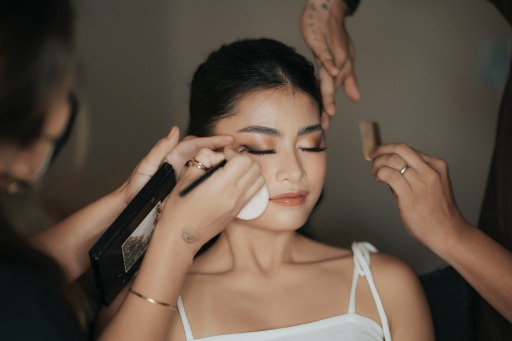In a world filled with bold makeup trends and dramatic transformations, there’s something effortlessly beautiful about the natural glow look. It’s not about masking your features—it’s about enhancing your natural beauty with minimal, skin-loving products. Whether you’re heading to work, brunch with friends, or a first date, the “no-makeup makeup” look is a timeless go-to for glowing, radiant skin.
But how exactly do you apply makeup for a natural glow? This guide takes you step-by-step through the process, helping you build a subtle and luminous makeup routine that lets your skin shine through—literally and figuratively.
Key Takeaways
- Skin prep is the foundation of a glowing look—never skip moisturizer or SPF.
- Use light layers of makeup to allow your natural skin to shine through.
- Opt for cream-based products to maintain a dewy, skin-like finish.
- Strategically use highlighter and blush for a healthy, radiant flush.
- Don’t over-powder—embrace the glow and only mattify oily zones.
- Choose minimal eye and lip products to balance the look.
- Consistency with skincare will enhance your natural glow over time.
Why Go for a Natural Glow Look?
Natural makeup isn’t just a trend—it’s a lifestyle. With growing awareness around skincare and a shift toward minimalist beauty, many are ditching heavy foundations and dramatic eye looks for a fresher, more breathable finish. A natural glow:
- Highlights your real skin
- Requires fewer products and less time
- Is perfect for daily wear and any age group
- Allows your personality and features to shine through
Plus, glowing skin is always in style.
Step-by-Step Guide: How to Apply Makeup for a Natural Glow
Start With Skin Prep
Glowing makeup starts with healthy, hydrated skin. Think of your skin as the canvas—you want it smooth, dewy, and well-nourished.
Steps:
- Cleanse to remove dirt, oil, or leftover makeup.
- Exfoliate gently (2–3 times a week) to smooth out texture.
- Tone to balance the skin’s pH and tighten pores.
- Moisturize with a lightweight, hydrating formula.
- Apply SPF daily, even when wearing makeup. Sun protection is non-negotiable.
Pro Tip: For extra glow, use a vitamin C serum or illuminating primer after moisturizing.
Use a Dewy Primer
A good primer not only helps your makeup last longer but also creates a smooth, glowing base. Choose a primer with light-reflecting particles or hydrating ingredients like hyaluronic acid.
Recommended Products:
- Illuminating primer (pearl or champagne-toned)
- Blurring primer with moisturizing properties
Go Easy With Foundation or BB Cream
Skip the heavy matte foundations. Instead, use a lightweight, breathable foundation, BB cream, or tinted moisturizer that evens your skin tone while allowing your natural skin to peek through.
Application Tips:
- Apply with a damp beauty sponge or fingertips for a natural finish.
- Focus only on areas that need coverage (like redness or uneven spots).
- Avoid layering too much—less is more!
Conceal Only Where Needed

Use a creamy concealer under the eyes, around the nose, or on blemishes. Don’t cake it on—just dab and blend.
Recommended Technique:
- Use a lightweight, hydrating concealer.
- Blend with your ring finger or a small blending brush.
Add Cream-Based Products for a Skin-Like Finish
Cream products mimic the texture of your skin, making them perfect for natural looks. Avoid powders that can dull the glow.
Products to Use:
- Cream blush in rosy or peachy tones
- Cream bronzer or contour stick for subtle definition
- Liquid or cream highlighter on high points of the face (cheekbones, brow bone, nose bridge, cupid’s bow)
Pro Tip: Blend everything with your fingers or a damp sponge to melt the product into the skin.
Lightly Define Your Brows
Natural brows should look full and feathery. Avoid sharp lines.
Steps:
- Brush brows upward using a spoolie.
- Use a brow gel or pencil to fill sparse areas lightly.
- Set with clear or tinted brow gel.
Soften the Eyes
Skip bold liners or heavy shadows. Instead, add a soft wash of neutral color.
Eyeshadow Tips:
- Use cream eyeshadow in a nude or peachy tone.
- Lightly contour the crease for subtle definition.
- Skip eyeliner or smudge a brown pencil close to the lash line.
Mascara:
- Apply one or two coats of brown or black mascara.
- Focus on separating and lifting lashes.
Set Strategically
Instead of baking or powdering the entire face, set only the areas that get oily—like the T-zone.
Setting Tips:
- Use translucent powder with a fluffy brush.
- Avoid mattifying too much to keep the glow intact.
Optional: A dewy setting spray can lock in the glow and prevent makeup from settling.
Use a Gloss or Tinted Balm on Lips
Glossy or hydrated lips scream natural beauty.
Lip Product Options:
- Tinted lip balm
- Sheer lipstick
- Gloss with a hint of color
Match your lip tone to your blush for a harmonious look.
Makeup for a Natural Glow by Skin Type

For Dry Skin:
- Prioritize hydration.
- Avoid matte finishes.
- Use oils or rich moisturizers before primer.
For Oily Skin:
- Use oil-free products.
- Choose a pore-blurring primer.
- Set makeup lightly but don’t over-powder.
For Mature Skin:
- Use light-reflecting formulas.
- Cream textures are key.
- Avoid powder-heavy products that settle into fine lines.
What’s the Difference Between Dewy and Matte Makeup?
Explanation:
Explore the fundamental differences between dewy and matte finishes in makeup, including skin types suited for each, how to achieve the look, key products, and trending combinations like “soft matte” or “natural glow.” Include product recommendations and tips for transitioning between looks.
How Can Skincare and Makeup Work Together for Better Results?
Explanation:
Bridge the gap between skincare and makeup by explaining how good skincare enhances makeup performance. Include product layering tips, skin prep before foundation, and how to choose makeup products that support skin health (e.g., non-comedogenic, SPF-infused).
How Do You Choose the Right Foundation for Your Skin Type and Tone?
Explanation:
Teach readers how to identify their skin type and undertone, match foundation shades properly (with indoor/outdoor tests), and choose between liquid, stick, powder, or cream formulas. Include tips for swatching and tools for application.
What Are the Best Natural Ingredients to Look for in Makeup Products?
Explanation:
Focus on the clean beauty trend. Highlight natural and skin-safe ingredients like jojoba oil, aloe vera, squalane, or green tea. Explain what to avoid (parabens, phthalates, etc.) and how to read labels for “greenwashing.”
How to Build a Beginner’s Makeup Kit for a Natural Look
Explanation:
List essential items (e.g., tinted moisturizer, concealer, mascara, brow gel, blush, lip balm), with product recs across budget levels. Include tips on organizing a kit, hygiene, and how to build confidence while practicing.
How to Transition Your Makeup Routine from Day to Night
Explanation:
Give practical steps for turning a natural, daytime look into something more dramatic for evening events without starting from scratch. Recommend multitasking products and tips for touch-ups, extra glow, or smoky eyes.
What Are the Common Mistakes to Avoid When Trying to Look Natural?
Explanation:
Break down subtle mistakes like using too much product, wrong shades, over-blending, or neglecting skin prep. Offer solutions and side-by-side comparisons for visual learners.
How Do You Create a Full Face of Makeup Using Only 5 Products?
Explanation:
Challenge minimalism: show how to use five products (e.g., BB cream, multi-stick for blush/lips, brow pencil, mascara, highlighter) for a complete face. Add tips for multifunctional use and on-the-go routines.
Why Skin Texture Is Normal—and How to Embrace It in Your Makeup Routine
Explanation:
Combat unrealistic beauty standards. Educate about normal skin texture (pores, fine lines, acne), how to work with it using makeup techniques, and why it’s okay not to aim for airbrushed perfection.
How Can You Make Your Makeup Last All Day Without Touch-Ups?
Explanation:
Focus on longevity: prep, layering techniques, long-wear product choices, and setting sprays/powders. Include routines for oily, combination, and dry skin types, and troubleshooting fading or caking.
How to Achieve a Natural Look With Minimal Makeup: A Step-by-Step Guide
Detailed Focus:
- The philosophy of “less is more” in makeup
- Minimalist skincare as the foundation for minimal makeup
- Key product categories (multi-use sticks, balms, tinted SPF, brow gels)
- Day-to-day routines for work, school, or home
- Psychological benefits of minimalist beauty
Bonus Section: Interviews or quotes from minimal beauty influencers
What’s the Ideal Skincare Routine Before Applying Makeup?
Detailed Focus:
- A.m. vs. p.m. skincare and their role in makeup readiness
- Cleansing, exfoliation, toning, serums, moisturizer, SPF—order and timing
- Skincare product ingredients that work well under makeup (like niacinamide, hyaluronic acid, vitamin C)
- Tips for prepping dry vs. oily vs. combination skin
- How long to wait between skincare steps and makeup application
Bonus Section: Product recommendations by skin type
What Are the Best Clean Beauty Brands for Natural Makeup?
Detailed Focus:
- What “clean beauty” actually means (including controversies and certifications)
- Top-rated clean/natural/vegan makeup brands in 2025 (e.g., Ilia, RMS Beauty, Kosas, Saie)
- Must-try hero products (like skin tints, lip oils, or multi-sticks)
- Ingredients to avoid (parabens, PEGs, synthetic fragrance)
Bonus Section: How to spot greenwashing on product labels
How Do You Create a Natural Bridal Makeup Look That Lasts All Day?
Detailed Focus:
- Planning and prepping skin months in advance
- Choosing waterproof, HD, and long-wearing natural-finish products
- Creating a glowy, timeless look for different skin tones
- Balancing natural with photography needs
Bonus Section: Checklist for bridal makeup trials
How to Choose the Right Blush Shade for a Natural Flush
Detailed Focus:
- Determining skin undertones (warm, cool, neutral) and matching blush
- Cream vs. powder vs. liquid blush: pros and cons
- Placement techniques for a natural lifted effect
- Trend breakdown: “sunburn blush,” “draping,” and more
Bonus Section: Blush recommendations by undertone and skin type
Can You Really Get a Natural Look With Drugstore Makeup? Yes—Here’s How
Detailed Focus:
- Budget-friendly makeup brands with high-performing natural-finish products (e.g., e.l.f., NYX, Maybelline)
- Dupes for popular luxury “no-makeup” products
- Affordable brushes and tools for beginners
- Building a full face under $50
Bonus Section: Side-by-side dupe vs. original comparison
How to Make Your Natural Makeup Last in Hot and Humid Weather

Detailed Focus:
- Sweat-proof primers and long-wear, breathable bases
- Setting sprays vs. setting powders—when and how to use each
- Tips for oil control without caking
- Avoiding melting, smudging, and shine throughout the day
Bonus Section: Portable touch-up products for summer
What’s the Role of Lighting in Achieving a Natural Makeup Look?
Detailed Focus:
- How different lighting (indoor, natural, fluorescent, ring lights) affects the appearance of makeup
- Techniques to apply and check makeup in various lighting conditions
- Using mirrors and phone settings to assess your final look
Bonus Section: Recommended vanity setups and lighting tools
How to Master the “No-Makeup” Makeup Look for Every Skin Tone
Detailed Focus:
- Shade-matching tips for foundation, blush, bronzer, and lip products across different complexions
- Culturally inclusive makeup brands and products
- How natural makeup techniques differ for light, medium, olive, tan, and deep skin
Bonus: Celebrity examples with different skin tones and product breakdowns
Why Your Skincare Routine Affects Your Makeup More Than You Think
Detailed Focus:
- The skin barrier and its impact on makeup application
- How dehydration, over-exfoliation, or clogged pores ruin finish and wear time
- Tailored skincare regimens for smoother, longer-lasting makeup
Bonus: “Glow from Within” morning skincare + makeup dual routine
How to Use Color Theory to Enhance Your Natural Features with Makeup
Detailed Focus:
- Understanding undertones and complementary colors
- How to make eyes pop using opposite shades on the color wheel
- Custom blush and lip combos to bring out natural radiance
Bonus: Interactive tools or color wheel printables
How to Do a Natural Makeup Look for Zoom, Photos, and Video Calls
Detailed Focus:
- Makeup that works best under webcams and artificial lighting
- Using matte/demi-matte strategically on oily zones
- Subtle eye, brow, and lip techniques that enhance facial expressions
Bonus: Side-by-side examples of “on-camera” vs. in-person makeup
The Ultimate Guide to Natural Makeup for Teens and First-Time Users
Detailed Focus:
- Age-appropriate products and light coverage techniques
- Establishing a skincare-first mindset early on
- Common beginner mistakes and how to avoid them
Bonus: “Starter kit under $100” for teens
How to Do Natural Makeup with Only Your Fingers
Detailed Focus:
- Advantages of finger application: warmth, blending ease, skin contact
- Best cream products for seamless finger blending
- Hygiene tips and when to avoid fingers (e.g., blemishes, bacteria)
Bonus: Quick 5-minute “finger-only” makeup routine
How to Apply Makeup for a Natural Look Over Acne-Prone Skin
Detailed Focus:
- Balancing coverage and breathability
- Ingredients to avoid in makeup (e.g., coconut oil, alcohols)
- Spot-concealing vs. full-face coverage techniques
Bonus: Dermatologist-approved acne-safe makeup brands
How to Create a Natural Glow Without Using Highlighter
Detailed Focus:
- Relying on skincare, foundation finishes, and blush placement
- Natural oils and dewy primers as highlighter substitutes
- Subtle glow from tinted moisturizers, balms, or glow drops
Bonus: DIY “glow serum” recipes from natural ingredients
How to Layer Cream, Liquid, and Powder Products for a Natural Finish
Detailed Focus:
- The “cream before powder” rule explained
- Product layering order for longevity and glow
- Mixing textures (e.g., liquid blush with powder bronzer)
Bonus: A one-face, multi-texture layering case study
How to Maintain a Natural Look When Touching Up Throughout the Day
Detailed Focus:
- Signs you’re over-touching and how to reset without caking
- Best on-the-go products: blotting papers, setting mists, hydrating sticks
- Tricks for reviving glow without reapplying full face
Bonus: Travel-friendly “mini kit” checklist
How to Blend Makeup Like a Pro for a Seamless, Skin-Like Finish
Detailed Focus:
- Importance of blending tools (fingers, brushes, sponges)
- Techniques for blending foundation, concealer, blush, bronzer, and eyeshadow
- Layering creams vs. powders
- Fixing harsh lines and Patchy textures
Bonus Section: Pro artist hacks for flawless blending
How to Transition Your Natural Makeup Routine for Every Season
Detailed Focus:
- Spring/Summer vs. Fall/Winter product adjustments
- Swapping textures (cream to powder, matte to hydrating)
- Skin tone changes through the year (and updating foundation matches)
- Seasonal color palettes and natural lip/cheek tones for each climate
Bonus Section: Capsule makeup wardrobe per season
Also read : Why Should Personal Care Be Part of Your Everyday Lifestyle?
Conclusion
The natural glow makeup look isn’t about perfection—it’s about celebration. It highlights your features rather than hiding them. With the right skincare prep, thoughtful product selection, and strategic application, you can achieve a radiant, effortless look that turns heads without screaming for attention.
Whether you’re a beginner or a beauty pro, mastering the art of glowing, natural makeup adds versatility and confidence to your routine. And the best part? It takes less time, feels more comfortable, and is healthier for your skin in the long run.
FAQs
Can I achieve a natural glow without foundation?
Yes! You can use just a tinted moisturizer, BB cream, or even just concealer where needed. Pair it with a good primer and highlighter for glow.
What’s the best highlighter for a natural glow?
Look for liquid or cream highlighters with fine shimmer. Champagne, rose gold, and pearl tones work well for most skin types.
How do I prevent my glowing makeup from looking oily?
Set only the oily areas (like the nose or forehead) with a translucent powder, and use a setting spray to control shine while preserving glow.
Is glowing makeup suitable for professional settings?
Absolutely. The natural glow look is subtle, clean, and polished—perfect for the workplace when done right.
Can I wear this look daily?
Yes. It’s designed for daily wear and is easy on the skin, especially when using non-comedogenic and breathable products.
What makeup products are must-haves for this look?
- Hydrating primer
- Lightweight foundation or BB cream
- Cream blush and highlighter
- Brow gel
- Mascara
- Lip balm or gloss
Should I avoid powder products altogether?
Not necessarily. Just use powders sparingly and choose finely milled or translucent formulas to set makeup without dulling your glow.
